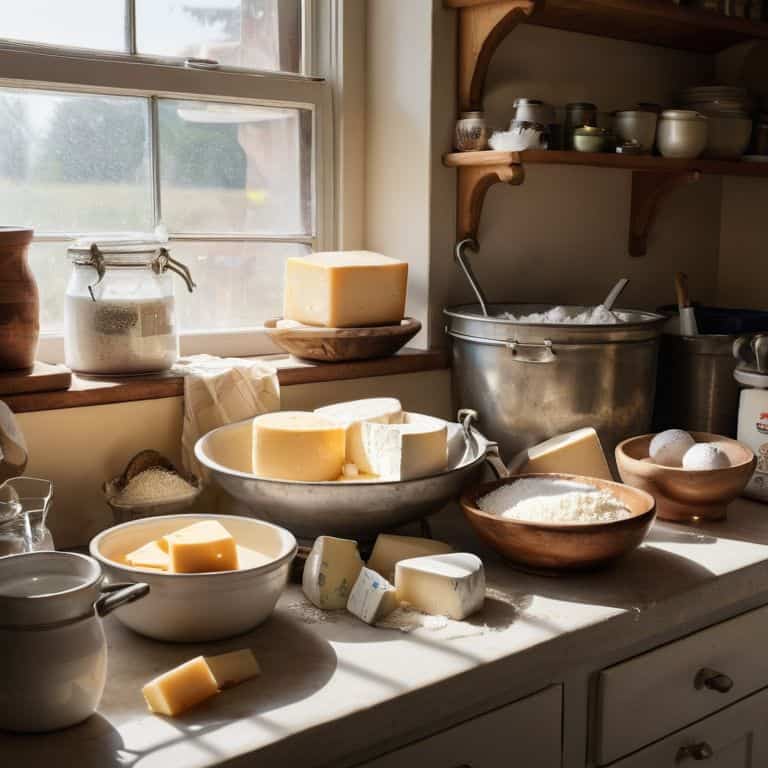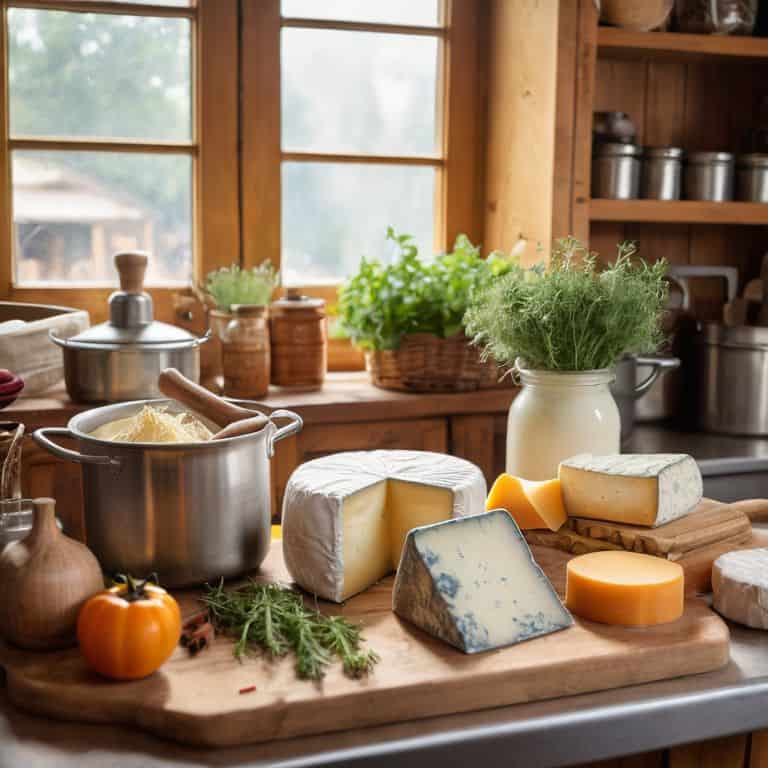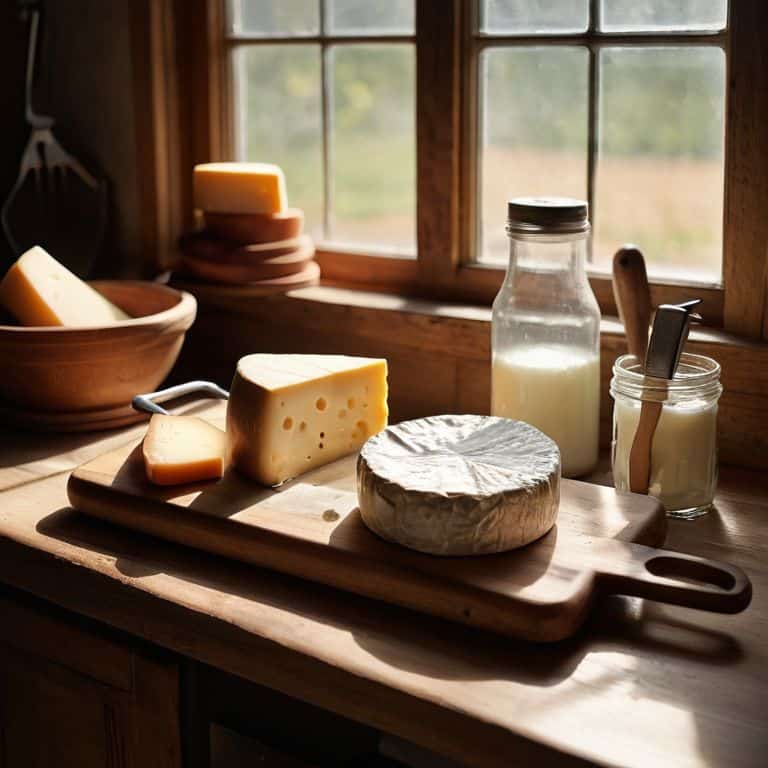I still remember the day I decided to ditch the cocktail bar scene and start experimenting with what you need to start making cheese at home. I had always been fascinated by the process of transforming raw ingredients into something truly magical, and cheese making was the ultimate challenge. The common myth that you need a fancy cheese cave or a plethora of expensive equipment to get started is simply not true. In fact, I’ve found that the most essential tools for cheese making are often the simplest ones.
As we dive into the world of DIY cheese production, I want to assure you that this guide is all about keeping it real and having fun. You won’t find any intimidating jargon or unrealistic expectations here. Instead, I’ll walk you through the honest, no-hype process of gathering the right ingredients and equipment to start making delicious cheese from scratch. We’ll cover the basics, from essential tools to fresh ingredients, and I’ll share some of my own tips and tricks for creating mouth-watering cheeses that will impress your friends and family. So, if you’re ready to get your hands dirty and unlock the secrets of homemade cheese, let’s get started!
Table of Contents
- Guide Overview: What You'll Need
- Step-by-Step Instructions
- Start Making Cheese
- Get Your Cheese On: 5 Essential Tips to Kickstart Your Journey
- Key Takeaways for the Aspiring Home Cheesemaker
- The Cheese Maker's Mantra
- Getting Started with Homemade Cheese: A Journey of Flavor and Discovery
- Frequently Asked Questions
Guide Overview: What You'll Need

Total Time: 2 hours 30 minutes
Estimated Cost: $50 – $100
Difficulty Level: Intermediate
Tools Required
- Large Pot (at least 4-quart capacity)
- Cheesecloth (for draining cheese)
- Colander (for draining cheese)
- Thermometer (accurate to 1 degree Fahrenheit)
- Cultures and Rennet (specific to the type of cheese being made)
Supplies & Materials
- Milk (whole, low-fat or nonfat, depending on the type of cheese)
- Cheese Cultures (mesophilic or thermophilic, depending on the type of cheese)
- Rennet (vegetable or animal, depending on the type of cheese)
- Salt (for flavor and preservation)
- Cheese Mold (optional, but recommended for shaping cheese)
Step-by-Step Instructions
- 1. First, let’s talk about the essential tools you’ll need to get started with making cheese at home. You’ll need a large pot, a cheese mold, and a thermometer. Don’t worry if you don’t have these things already – they’re easy to find at your local kitchen supply store or online. I like to think of this step as the foundation of your cheese-making journey, where you’re setting yourself up for success by having the right equipment.
- 2. Next, you’ll need to gather your ingredients, which will depend on the type of cheese you want to make. For a simple cheese like ricotta or mozzarella, you’ll need fresh milk, cheese cultures, and rennet. I always say that the quality of your ingredients is directly related to the quality of your final product, so try to use the best milk you can find. Organic or farm-fresh milk is ideal, but regular milk from the grocery store will work too.
- 3. Now it’s time to sterilize your equipment, which is a crucial step in preventing contamination and ensuring your cheese turns out well. You can do this by washing all of your equipment in hot soapy water, and then rinsing it thoroughly. I also like to sanitize my equipment with a little bit of vinegar or bleach solution, just to be extra safe.
- 4. With your equipment and ingredients ready, it’s time to start heating your milk. This is where things can get a little tricky, as you’ll need to heat the milk to a very specific temperature – usually around 145°F – to kill off any bacteria that might be present. Use your thermometer to monitor the temperature, and be patient – this step can take a while.
- 5. Once your milk has reached the correct temperature, it’s time to add your cheese cultures and rennet. This is where the magic happens, and your milk starts to transform into cheese. The type and amount of cultures and rennet you use will depend on the type of cheese you’re making, so be sure to follow a recipe or instructions specific to your cheese.
- 6. After you’ve added your cultures and rennet, you’ll need to let the mixture sit for a while – usually around 30-60 minutes – to allow it to coagulate. This is a great time to grab a cup of coffee or do a few chores, as you won’t need to do much except wait. Just be sure to keep an eye on the mixture, as you’ll need to cut it into curds once it’s fully coagulated.
- 7. Finally, it’s time to shape your cheese and let it age. This can be the most fun part of the process, as you get to see your cheese take shape and develop its flavor and texture. Depending on the type of cheese you’re making, you may need to shape it into a ball, a wheel, or a block – or you may need to let it age for a few days or weeks before it’s ready to eat. I love this part of the process, as it’s where you get to see the fruits of your labor and enjoy the delicious cheese you’ve made.
Start Making Cheese

As you dive into the world of cheese making, remember that it’s all about experimentation and having fun. Don’t be afraid to try out beginner cheese recipes and see what works best for you. With a little practice, you’ll be creating your own unique types of cheese to make at home in no time.
When it comes to cheese making for dummies, it’s essential to invest in a good home cheese making equipment kit. This will include everything you need to get started, from cheese cultures and enzymes to molds and aging equipment. Don’t worry if it seems overwhelming at first – with a little patience and practice, you’ll be a pro in no time.
As you progress in your cheese-making journey, you’ll want to explore the art of affinage at home. This involves carefully monitoring the aging process to bring out the perfect flavors and textures in your cheese. With a little dedication and the right equipment, you’ll be creating delicious, artisanal cheeses that will impress even the most discerning palates. Cheese cultures and enzymes will become your new best friends, helping you to craft unique and complex flavors that will elevate your cheese-making game.
Beginner Cheese Recipes Uncovered
Now that you’ve got your hands dirty, let’s dive into some beginner-friendly cheese recipes. I’m obsessed with experimenting, and I’ve found that simple cheeses like ricotta and mozzarella are perfect for starters. You can whip them up in no time and they’re incredibly versatile – think homemade pizzas, lasagnas, and cannoli.
For a deliciously easy start, try my favorite ricotta recipe, which only requires milk, vinegar, and a pinch of salt. The result is a creamy, tender cheese that’s perfect for spreading on crackers or using in your favorite Italian dishes. Trust me, once you taste the difference of homemade cheese, you’ll be hooked!
Essential Home Cheese Making Equipment Kits
Now that we’re diving into the world of homemade cheese, let’s talk about the essential tools you’ll need to get started. I like to think of it as assembling my own DIY cheese-making squad. You’ll need a large pot for heating milk, a cheese mold to shape your creations, and a thermometer to monitor temperatures.
A good cheese-making equipment kit usually includes these basics, along with some extras like cheesecloth and a culture or rennet. Don’t worry if you don’t know what all these terms mean just yet – we’ll get into the nitty-gritty as we experiment with different recipes. The key is to have fun and be willing to try new things. With the right tools and a bit of practice, you’ll be crafting your own unique cheeses in no time.
Get Your Cheese On: 5 Essential Tips to Kickstart Your Journey
- Dive into the world of cheese making with a thermometer – it’s your new best friend for monitoring temperatures
- Source the freshest milk possible, whether it’s from a local dairy or your own backyard goat (if you’re feeling adventurous)
- Don’t be afraid to experiment with different cultures and enzymes – they’re the magic makers in your cheese
- Invest in a good cheese cloth or butter muslin – you’ll be using it to drain and shape your creations
- Keep it clean, keep it simple – sanitize your equipment and workspace to avoid any unwanted visitors (like bacteria) in your cheese
Key Takeaways for the Aspiring Home Cheesemaker
Start small and experiment with beginner-friendly cheese recipes like mozzarella, ricotta, or feta to build your confidence and skills in the kitchen
Invest in a basic home cheese making equipment kit that includes essentials like cheese cultures, rennet, and a thermometer to ensure you’re setting yourself up for success
Remember, the art of crafting cheese from scratch is all about embracing the process, being patient, and having fun – don’t be too hard on yourself if things don’t turn out perfectly at first, just enjoy the journey and learn as you go
The Cheese Maker's Mantra
To start making cheese at home, all you need is a willingness to get a little messy, a curiosity for the craft, and a passion for transforming simple ingredients into something truly extraordinary – the rest is just milk and magic!
Tom Navarro
Getting Started with Homemade Cheese: A Journey of Flavor and Discovery

As we’ve explored the world of homemade cheese, it’s clear that getting started is easier than you think. You’ve learned about the essential equipment and key ingredients needed to begin your cheese-making journey. From the basics of cheese cultures to the art of shaping and aging, we’ve covered the fundamental steps to create your own delicious cheeses at home. Whether you’re a beginner or an experienced maker, the process of crafting cheese from scratch is a rewarding experience that connects you with the food you eat and the people you share it with.
So, what’s next? Now that you have the foundation, it’s time to get creative and experiment with new flavors and recipes. Remember, the art of cheese making is all about trial and error, and the most important ingredient is your willingness to learn and have fun. As you embark on this culinary adventure, keep in mind that every batch of homemade cheese is a reflection of your passion and dedication to quality, local ingredients. Happy cheese making, and I look forward to hearing about your own cheese-making journeys and the delicious creations that come out of your kitchen!
Frequently Asked Questions
What are the most essential ingredients I need to get started with making cheese at home?
Ah, the fun part! To get started, you’ll need some basic ingredients like milk, cheese cultures, and enzymes. I like to use whole milk from local farms for its rich flavor. You’ll also need some cheese salt and possibly some additional flavorings like garlic or herbs. Don’t worry too much about the specifics – we’ll experiment and find your perfect blend!
Can I use regular store-bought milk or do I need to find a specialty milk for cheese making?
Ah, milk – the foundation of great cheese! You can definitely use regular store-bought milk, but keep in mind it might have been ultra-pasteurized, which can affect the cheese’s flavor and texture. I like to use raw or low-temperature pasteurized milk from local farms for a richer taste, but feel free to experiment with what you have on hand!
Are there any specific safety precautions I should take when working with cheese cultures and bacteria at home?
Absolutely, safety first! When working with cheese cultures and bacteria, make sure to handle them in a clean environment, and always sanitize your equipment. Wash those hands thoroughly, and consider wearing gloves to avoid cross-contamination. I like to think of it as a mini science lab in my kitchen – respect the process, and you’ll be rewarded with amazing flavors!
